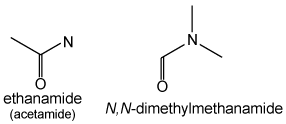Amide: Difference between revisions
imported>Nathaniel Gunby (New page: {{Image|IUPAC-amide.png|right|350px|two simple organic amides.}} This article is about the acid derivatives. There are also ionic amides, which are very strong bases and the nitrogen equi...) |
imported>Nathaniel Gunby No edit summary |
||
| Line 2: | Line 2: | ||
This article is about the acid derivatives. There are also ionic amides, which are very strong bases and the nitrogen equivalents of [[hydroxide]], with the general formula R<sub>2</sub>N<sup>-</sup>(where R refers to hydrogen or any alkyl group. | This article is about the acid derivatives. There are also ionic amides, which are very strong bases and the nitrogen equivalents of [[hydroxide]], with the general formula R<sub>2</sub>N<sup>-</sup>(where R refers to hydrogen or any alkyl group. | ||
In general, an '''amide''' is drived from an oxoacid (an acid containing a central atom double bonded to at least one oxygen atom and singly bonded to at least 1 OH group) by replacing the OH group(s) with NR<sub>2</sub>- for instance, a [[sulfonic acid]] gives a [[sulfonamide]]. The most important amides are organic amides, derived from [[carboxylic acid|carboxylic acids]]. While these appear to contain a [[carbonyl]] bonded to an [[amine]], their reactivity is very different from either of those two [[functional group|functional groups]], due to [[resonance]] delocalistion of the nitrogen's lone pair into the carbonyl system. This makes the carbonyl less reactive than most carboxylic acid derivatives in [[electrophile|electrophilic]] substitution reactions, and makes the nitrogen much less [[nucleophile|nucleophilic]] than it is in amines. In those reactions where amines do react as nucleophiles, they react through the oxygen instead of the nitrogen. It also lends partial double bond character to the carbonyl-nirtogen bond, limiting rotation around it. | In general, an '''amide''' is drived from an oxoacid (an acid containing a central atom double bonded to at least one oxygen atom and singly bonded to at least 1 OH group) by replacing the OH group(s) with NR<sub>2</sub> - for instance, a [[sulfonic acid]] gives a [[sulfonamide]]. The most important amides are organic amides, derived from [[carboxylic acid|carboxylic acids]]. While these appear to contain a [[carbonyl]] bonded to an [[amine]], their reactivity is very different from either of those two [[functional group|functional groups]], due to [[resonance]] delocalistion of the nitrogen's lone pair into the carbonyl system. This makes the carbonyl less reactive than most carboxylic acid derivatives in [[electrophile|electrophilic]] substitution reactions, and makes the nitrogen much less [[nucleophile|nucleophilic]] than it is in amines. In those reactions where amines do react as nucleophiles, they react through the oxygen instead of the nitrogen. It also lends partial double bond character to the carbonyl-nirtogen bond, limiting rotation around it. These reactivity patterns are true of amides derived from other acids as well. | ||
Organic amides are important biologically, because [[protein|proteins]] are made of [[amino acid|amino acids]] held together by amide groups. An amide formed from two aminoe acids is called a peptide bond. | Organic amides are important biologically, because [[protein|proteins]] are made of [[amino acid|amino acids]] held together by amide groups. An amide formed from two aminoe acids is called a peptide bond. | ||
Revision as of 18:46, 28 October 2010
This article is about the acid derivatives. There are also ionic amides, which are very strong bases and the nitrogen equivalents of hydroxide, with the general formula R2N-(where R refers to hydrogen or any alkyl group.
In general, an amide is drived from an oxoacid (an acid containing a central atom double bonded to at least one oxygen atom and singly bonded to at least 1 OH group) by replacing the OH group(s) with NR2 - for instance, a sulfonic acid gives a sulfonamide. The most important amides are organic amides, derived from carboxylic acids. While these appear to contain a carbonyl bonded to an amine, their reactivity is very different from either of those two functional groups, due to resonance delocalistion of the nitrogen's lone pair into the carbonyl system. This makes the carbonyl less reactive than most carboxylic acid derivatives in electrophilic substitution reactions, and makes the nitrogen much less nucleophilic than it is in amines. In those reactions where amines do react as nucleophiles, they react through the oxygen instead of the nitrogen. It also lends partial double bond character to the carbonyl-nirtogen bond, limiting rotation around it. These reactivity patterns are true of amides derived from other acids as well.
Organic amides are important biologically, because proteins are made of amino acids held together by amide groups. An amide formed from two aminoe acids is called a peptide bond.
Synthesis
- Reaction of most other carboxylic acid derivatives with ammonia, a primary amine, or a secondary amine will give an amide. By using derivatives of other acids [such as sulfuric], their amides can be obtained
- Organic amides may be formed by hydrolysing nitriles
Reactivity
- Concentrated acid or base will hydrolyse amides to thier parent acids.
- Organic amides can be dehydrated to nitriles.
- Lithium aluminium hydride will reduce organic amides to amines
- The Hofmann rearrangement will convert an organic amide without alkyl groups on the nitrogen to an amine with one fewer carbon atom
